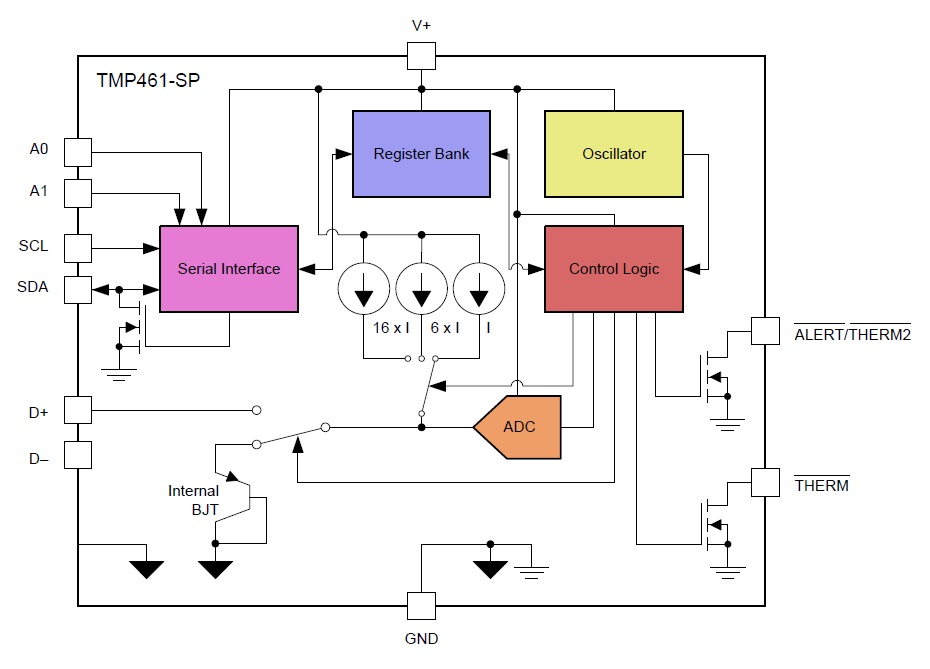A new radiation-hardened temperature sensor offers both local and remote digital temperature monitoring.

Block diagram of TI’s TMP461-SP. Drawing from the datasheet (PDF).
TI explains to us, regarding the radiation-hardened aspect of this IC, that this high-accuracy temperature sensor is QMLV qualified. Now, unless you're in the business of designing, selling, or using radiation-hardened ICs, you may not know what QMLV means. QMLV stands for Qualified Manufacturer List (QML) class V, where the V class is related to space applications. Furthermore, QMLV is part of the MIL-PRF-38535 specification, which is described as being a performance-based specification defining the requirements for the manufacturing of microelectronics for use in "military applications and high-reliability microcircuit application programs." So it seems to me that QMLV-qualified products are impressive, a bit intimidating, and expensive. But hey, I suppose if you're in the business of placing electronics in space, then this is the price you have to pay. Besides, you want something that will survive all the radiation nastiness that space offers, right?

The TMP461-SP is a radiation-hardened temperature sensor. It looks pretty tough to me. Image courtesy of TI.com.
Temperature Sensing
Local Sensing
Local temperature sensing is made possible by the IC's built-in temperature sensor. This local measurement, which is represented by a 12-bit digital code, allows for a temperature resolution of 0.0625°C. Keep in mind, however, that while this temperature resolution is quite impressive, the accuracy of the local temperature sensor is only ±2°C across its temperature range of -55°C to 125°C.If you're looking for highly responsive local temperature-sensing capabilities, then this part may not be well suited for your needs since it has a thermal time constant of approximately two seconds. What does this mean?, you might be asking. Well, TI has kindly provided an example in Section 8.2.2 (entitled Detailed Design Procedure) of the datasheet: if the ambient air temperature rapidly changes by 100°C, then the IC requires about 10 seconds (or five thermal time constants) to settle within 1°C of the final value. This section also explains that the accuracy of the local temperature measurement directly depends on how accurately the PCB and forced airflow temperatures are representative of the temperature that the IC itself is measuring. So, in order to get the most out of this IC, be sure to check out this area of the datasheet.
Remote Sensing
Remote temperature sensing is achieved, according to Section 3 of the datasheet (entitled Description), by using discrete transistors or by use of substrate thermal transistors or diodes that are integral to microprocessors, ADCs, DACs, microcontrollers, or FPGAs. Remote sensing offers the same resolution as local sensing (i.e., 0.0625°C), and accuracy is slightly better (±1.5°C instead of ±2°C).A final comment on temperature sensing. Section 7.3.1 (entitled Temperature Measurement Data) explains how an extended temperature range (from -64°C to 191°C) is possible. But, we are also cautioned that most temperature-sensing diodes have an operational temperature range of -55°C to 150°C, and of course the TMP461-SP IC itself has an operating temperature range of -55°C to 125°C, which means the local temperature sensing functionality is limited to this same range. So, if your design needs to measure some seriously extreme temperatures, be sure to review this section in the datasheet.
Other Features
With the goal of reducing measured temperature errors, this IC incorporates the following features:Series Resistance Cancellations
Temperature errors are caused by any resistance associated with the routing to the remote sensing component. The Series Resistance Cancellation feature of the TMP461-SP automatically eliminates up to 1 kΩ of series resistance. The image below depicts the relationship between series resistance and temperature errors. For more information on this topic, refer to Section 7.3.2 (Series Resistance Cancellation, page 12) of the datasheet.
We can see how series resistance impacts, albeit only slightly, remote temperature measurement accuracy. Plot taken from the datasheet (PDF).
Differential Input Capacitance
TI also explains, in Section 7.3.3 on page 12 of the datasheet, how capacitance also influences the remote sensing temperature accuracy. And while the TMP461-SP can tolerate up to 1000 pF of differential input capacitance with minimal associated error, the figure below shows us how larger differential capacitance values have an extreme impact on accuracy.The remote temperature error is seriously affected by differential capacitance greater than ~5 nF. From the datasheet (PDF).
Filtering: Analog and Digital
The Filtering section (page 12 of the datasheet) explains how the TMP461-SP makes use of an on-board 65 kHz digital filter and external capacitors for minimizing the effects of noise.Evaluation Kit
If you're interested in giving this device a test drive, consider purchasing the evaluation module, which comes with a user's guide and software tutorial.
The TMP461EVM-CVAL evaluation module. Image courtesy of TI.com.
Have you had a chance to use this new radiation-hardened temperature sensor, or its evaluation kit? If so, leave a comment and tell us about your experiences.








No comments:
Post a Comment